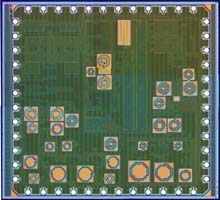
The wireless local area network (WLAN) chips independently developed by CAS researchers were in the limelight of the recent Electronic Manufacture Exposition held in Suzhou, east China's Jiangsu Province.
A WLAN is a wireless local area network, which is the linking of two or more computers without using wires. It uses radio communication to accomplish the same functionality that a wired LAN has. WLAN utilizes spread-spectrum technology based on radio waves to enable communication between devices in a limited area, also known as the basic service set. This gives users the mobility to move around within a broad coverage area and still be connected to the network. This technology is becoming more and more popular, especially with the rapid emergence of small portable devices such as PDAs (personal digital assistants).
With the support of the CAS Knowledge Innovation Program, researchers from the CAS Institute of Semiconductors started their work on the WLAN chips in May 2004. One year later, they made a breakthrough progress in the research and development of direct digital frequency synthesizer (DDS) chips with synthesized clock frequency up to 2GHz, doubling the speed of similar products in the world at that time. In August 2006, the first WLAN chips were successfully developed.
Experts say that the success in the chips, which operate in the frequency band of 5GHz in compliance with the IEE 802.11a standard, marks the upgrading of China's competitiveness in developing high-end radio frequency and mixed analogue-digital chips.





